
Hanoi Tours Expert‘s Food Guide – Must Eat Foods – Reliable Local Restaurants
The best Hanoi dishes are inexpensive yet tasty treats that can be found within Hanoi Old Quarter’s narrow alleyways and bustling street markets. Compared to other cities in Vietnam, Hanoi food tends to be on the sweeter side and utilises freshwater ingredients such as prawns, squids, shrimps, crabs, clams, and mussels. You can also find familiar Vietnamese street food such as pho noodles, spring rolls, rolled cakes, and skewered meat.
HANOI FOOD: THE BEST DISHES TO TRY
1/ Phở Bò (Noodle soup with Beef)
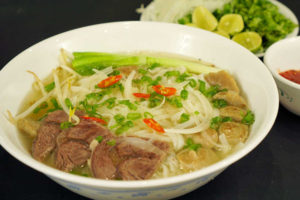
Phở Bò (Noodle soup with Beef)
Phở Bò is a dish that you’ll consume frequently during your trip to Vietnam. Phở Bò is simply beef noodle soup and is the classic preparation of this ubiquitous dish.
Pho Bo starts with steaming beef broth that has been simmering on the stove since early in the morning. The broth is poured over a bowl full of rice noodles, onions, and scallions. It’s then topped with various cuts of beef and a pinch of cilantro.
Your Pho comes served with a plate of fresh bean sprouts, basil, mint, jalapeno slices, and a lime wedge so you can season your bowl to your own personal taste. You’ll also find pickled garlic, fish sauce, black pepper, and Hoisin sauce on the table at most Pho restaurants if you want to experiment with flavors.
Pho Ly Quoc Su
- Address: 10 Ly Quoc Su street, Ward Hang Trong, District Hoan Kiem.
- Price: 50,000 – 80,000 VND
Pho Bat Dan
- Address: 49 Bat Dan street, District Hoan Kiem.
- Price: 30,000 – 60,000 VND
2/ Phở Gà (Noodle soup with chicken)

Phở Gà (Noodle soup with chicken)
Phở gà (chicken pho) is lighter than beef pho, and it is a natural remedy for a common cold. Similar to beef pho, it is usually served with chopped spring onions, coriander, onion slices and also quẩy, deep-fried flour-based snacks that are crunchy on the outside and chewy on the inside.
Locals tend to dip them into their soup to let them absorb the tasty broth. The Vietnamese prefer chicken thighs to breasts, so chicken thigh pho is a little more expensive.
Address: 31 Hang Khoai, Hanoi, Vietnam
42 Quan Thanh Street, Ba Dinh District, Hanoi
Price: ~$2 USD
3/ Bún Chả (Barbecued Pork with Rice Vermicelli)

Bún Chả (Barbecued Pork with Rice Vermicelli)
Bún Chả, is one northern Vietnamese food that quickly became our favorite. It is one of the best Hanoi food specialty not to be missed.
The dish consists of grilled pork strips and balls or chả served over a bed of rice vermicelli noodles or bún. It typically comes with a plate of fresh Vietnamese herbs and a bowl of dipping sauce. Pickled vegetables, like cabbage, carrots, onion or green papaya served with additional meatballs on the side.
The sauce is made of the famous Vietnamese fish sauce or Nuoc Mam combined with vinegar, lime, sugar, garlic and chili.
Bún Chả Hương Liên
- Address: 24 Le Van Huu Street in Hai Ba Trung District
- Hours: Everyday from 8:00 am to 9:00 pm
- Prices: About 40,000 VND to 50,000 VND ($1.77 USD to $2.21 USD)
Bún Chả Hàng Mành – Đắc Kim
- Address: 1 Hang Manh Street
- Hours: Everyday from 10:00 am to 9:00 pm
- Prices: About 60,000 VND ($2.65 USD)
4/ Chả Cá (Turmeric Fish with Dill)
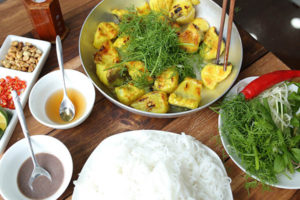
Chả Cá (Turmeric Fish with Dill)
A distinctive Hanoi delicacy, cha ca is white fish seasoned with garlic, ginger, turmeric, and dill served on sizzling pan. Diners also get a bowl of rice noodles, peanuts, chopped spring onions, parsley, nuoc cham sauce, and red chili slices, all of which are meant to be mixed together with the turmeric fish. Cha ca is so popular amongst locals that there’s a street in Hanoi Old Quarter named after it, though the best (and affordable) places to enjoy this seafood delicacy is at Cha Ca Thang Long in Duong Thanh Street.
Chả Cá Thăng Long
- Address: 19 – 21 – 31, Duong Thanh, Hoan Kiem, Hanoi
- Hours: Everyday from 11:00 am to 9:30 pm
- Prices for Cha Ca: 120,000 VND per person, (approximately $5.29 USD)
Chả Cá Lã Vọng
- Address: 14 Chả Cá, Hà Nội.
- Hours: Everyday from 11:00 am to 2:00 pm and 5pm to 9pm.
- Opening Hours: Daily 10:00 – 15:00, 17:00 – 22:00
- Address: 21 Duong Thanh Street, Old Quarter
5/ Bánh Mì (Vietnamese Sandwich)
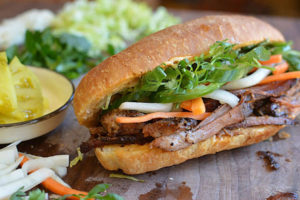
Bánh Mì (Vietnamese Sandwich)
The Bánh Mì sandwich is truly the best Vietnamese sandwich to fall in love with. While its origins are French, the Vietnamese have made it distinctively their own. Generally speaking it is an airy Vietnamese baguette made with a combination of wheat and rice flours with a thin crispy crust.
It is stuffed with pork, pâté, cured ham, a mélange of Vietnamese herbs and vegetables like coriander, cucumber, carrot, slices, radish and more depending on what part of the country you are in. A wealth of textures and flavors, you will savor spicy, salty, savory, sweet, and aromatic tastes in each bite.
Bánh Mì 25
- Address: 25 Hàng Cá, P, Hoàn Kiếm, Hà Nội, Vietnam
- Operating Hours: 7AM-9PM, daily
- What to Order: Mixed banh mi with pate, barbecued pork, ham, and sausage
- What We Paid: VND 20,000-40,000 per banh mi
Bánh Mì Ngon
- Address: 49 Đường Thành, Hà Nội.
- Hours: Everyday from 8 am until 10 pm.
- Prices: About 15,000 VND to 25,000 VND ($0.66 USD to $1.10 USD)
6/ Bún Ốc (Snail Vermicelli Rice)
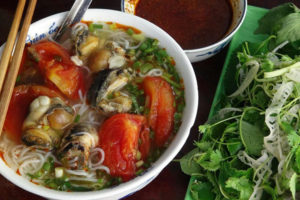
Bún Ốc (Snail Vermicelli Rice)
Bún ốc is one of the top suggestions of Hanoi specialties for you. Bun oc is processed as per traditional cuisine. The broth is concentrated, strong, twinkle yellow of fried onions, sour, soft and natural sweet taste.
A bowl of Bun oc has both types of oc (small and big snail) plus with green fried banana and soya cheese. Each snail is select carefully to ensure the quality and bring the delicious taste.
- Place: 43 Nguyễn Siêu street, Hoàn Kiếm district / 13 Hòe Nhai street. Ba Đình district
- Price: ~2USD
7/ Bánh Cuốn (Steamed Rice Rolls)
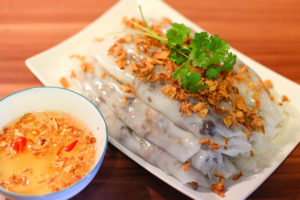
Bánh Cuốn (Steamed Rice Rolls)
Bánh cuốn is another local specialty from Northern Vietnam that you don’t want to miss. It is a delicate and light dish usually eaten for breakfast in Vietnam. However, you can find it all day long.
Bánh cuốn is made of a thin rice sheet rolled and filled with ground pork meat and minced mushrooms. It is served with fried shallots and cilantro herbs on top.
The secret flavor of this Hanoi food resides in its dipping sauce. As with most Vietnamese dishes, Nuoc Mam of fish sauce is used in the dipping sauce. The magic comes with the additional drop of cà cuống, the essence of a giant water bug common in Southeast Asia.
This drop in the sauce adds an extra flavor which gives off a taste similar to scallops or shrimps. Today, this natural essence is becoming scarce and many restaurants are now using an imitation essence. The rice sheet is made by steaming fermented rice batter on a cloth stretched over a pot of boiling water.
Bánh Cuốn Gia Truyen
- Address: 12 Hàng Gà, Hà Nội.
- Hours: Everyday from 7:00 am to 1:00 pm and 5pm to 11pm
- Prices: About 35,000 VND per person, (approximately $1.54 USD)
8/ Lẩu (Hot Pot)
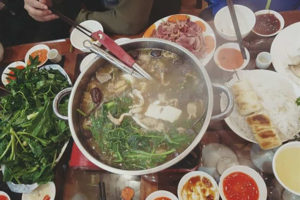
Lẩu (Hot Pot)
In the cooler months, Lau is one of the most popular food you will find in Hanoi. Sitting on the sidewalks, in the evenings, you will see groups of locals huddled together over a large pot of simmering soup, cooking beef, chicken, fish, noodles, veggies and so on. Next to the tables, you will find vendors with a display filled with different vegetables and protein to be added to the hot pot.
There are many different kinds of hot pots. Frog, is one of the most popular ones that we saw followed by chicken and seafood. As this is a large dish that is meant for sharing with several people, we did not order it. Though it is one of the authentic Vietnamese dishes you must eat in Hanoi.
9/ Bún Cá – Fish Noodle Soup

Bún Cá – Fish Noodle Soup
In northern Vietnam, fresh water fish is widely used in dishes. This Hanoi food Bún Cá, is no exception.
It is a light broth made from fish bones with golden fresh white fish lightly fried. At the bottom of the soup, is a bed of rice vermicelli noodles. On the top covering the broth, is a delicate combination of spring onions and bean sprouts mixed with dill herbs.
Bún Cá Sâm Cây Si
- Adress: 5 Ngõ Trung Yên, Hà Nội.
- Hours: Everyday from 8:00 am to 8:30 pm
- Prices: About 35,000 VND per person, (approximately $1.54 USD).
10/ Miến Xào Lươn (Glass Noodles with Deep-Fried Eel)
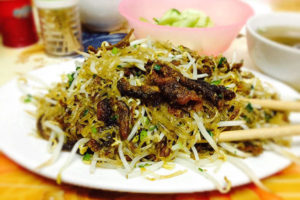
Miến Xào Lươn (Glass Noodles with Deep-Fried Eel)
Mien xao luon is another tasty option for seafood lovers, comprising stir-fried glass noodles in an eel-based broth with generous toppings of crunchy eels, bean sprouts, egg, cucumber slices, fried shallots, and purple perilla. As with many dishes in Hanoi, a side of fresh herbs, shaved banana blossoms, and bean sprouts are served on the side. Dong Thinh Nha Hang Mien Luon at Hoan Kiem District is a local hangout spot for mien xao luon, where dishes are priced between VND 35,000 and VND 50,000.
- Opening Hours: Daily 17:00 – 23:00
- Address: 87 Hang Dieu, Hoan Kiem District, Hanoi
11/ Bún Thang (Rice Vermicelli with Chicken, Egg, Pork)

Bún Thang (Rice Vermicelli with Chicken, Egg, Pork)
Bun thang or rice vermicelli with chicken, egg and pork can be enjoyed at any time of the day. The clear yet flavourful broth is made with 20 ingredients, including dried shrimp, squid, shrimp paste, spring onion, coriander, ginger, mushroom, beet, fish sauce, sugar candy, and vinegar. It is also a particularly attractive Hanoi dish as the noodles, chicken, eggs, pork slices, and a dollop of shrimp paste are carefully arranged to resemble a flower. Available mostly within Hanoi Old Quarter, we highly recommend Bun Thang Ba Duc as you can enjoy a generous bowl of bun thang for about VND 30,000.
- Opening Hours: Daily 18:00 – 22:00
- Address: 48 Cau Go, Hoan Kiem District, Hanoi
12/ Bánh Gối (Fried Dumplings)
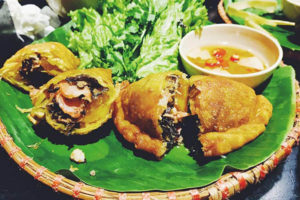
Bánh Gối (Fried Dumplings)
Shaped like miniature pillows (hence the name), banh goi contains finely-chopped glass noodles, wood ear mushrooms, minced pork, steamed quail eggs, and seasoning within a rice-flour pastry. It is then deep-fried for a crispy texture and served with a sweet-sour dipping sauce made with garlic, chilli, sugar, lime juice, and fish sauce. You can also pair your banh goi with fresh lettuce and coriander leaves if you find it too greasy to enjoy it on its own.
- Opening Hours: Daily 10:00 – 21:00
- Address: 52 Ly Quoc Su, Hoan Kiem District, Hanoi
13/ Xôi Xéo (Sweet Sticky Rice)
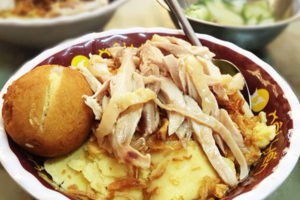
Xôi Xéo (Sweet Sticky Rice)
Xoi xeo or sweet sticky rice usually comes with staple toppings of green mung bean paste, soy sauce, and dried shallots, but you can opt for a variety of add-ins such as pate, boiled chicken, cha lua (Vietnamese ham), marinated pork belly, or preserved eggs for a more substantial meal. Some restaurants also serve xoi xeo as dessert, topped with dried coconut shavings, roasted sesame seeds, and crystallised sugar. An inexpensive yet prominent xoi xeo restaurant is Xoi Yen, where you can enjoy a basic bowl for VND 15,000, with additional ingredients between VND 15,000 and VND 30,000.
- Opening Hours: Daily 07:00 – 22:00
- Address: 35B Nguyen Huu Huan, Hoan Kiem District, Hanoi
14/ Phở Xào (Stir-Fried Pho)
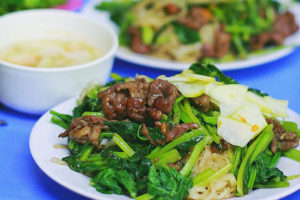
Phở Xào (Stir-Fried Pho)
Pho may be best known as rice noodles served in soup, but you can also enjoy it in the form of pho xao, which is stir-fried with onions, beef slices, and assorted greens. The flat pho noodles are usually crisp on the outside with a smooth glutinous texture, and most restaurants sometimes add fried eggs and chilli sauce to this simple yet satisfying dish. Thin is a family-run restaurant within Hai Ba Trung District, where you can savour pho xao for only VND 50,000.
- Opening Hours: Daily 06:00 – 15:00
- Address: 13 Lo Duc, Hai Ba Trung District, Hanoi
15/ Nem Cua Bể (Crab Rolls)
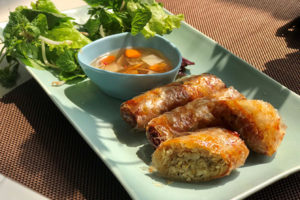
Nem Cua Bể (Crab Rolls)
A popular Vietnamese street food, nem chua be (crabmeat rolls) are sold in street markets and local restaurants within Hanoi – a good choice is Bun Cha Nem Cua Be Dac Kim in Hanoi Old Quarter. This crispy snack is shaped like a square and cut into bite-sized pieces, containing generous fillings of minced crab, pork, mushrooms, and various spices. Eat like the locals do by pairing nem chua with fresh herbs and lettuce, as well as dipping it in nuoc cham sauce.
- Opening Hours: Daily 11:00 – 19:00
- Address: 67 Duong Thanh Street, Old Quarter, Hanoi
16/ Chim Quay (BBQ Pigeon)
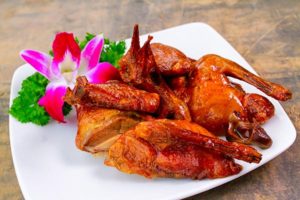
Chim Quay (BBQ Pigeon)
If you’re an adventurous food lover, then chim quay at Chim Quay Bit Tet is a must-try when you’re in Hanoi. A less fatty version of a Chinese-style roast duck, this dish comprises a whole pigeon seasoned with various spices and barbecued until crispy. Another variation of this dish is the nom chim quay, which is BBQ pigeon served atop a bed of lettuce, cooked onions, carrots, and papaya slices.
- Opening Hours: Daily 10:00 – 23:00
- Address: 20 Hang Giay Street, Old Quarter, Hanoi
17/ Bún Riêu (Rice Noodles in Tomato Broth)
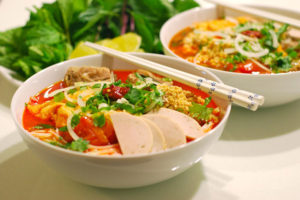
Bún Riêu (Rice Noodles in Tomato Broth)
Bun rieu comprises thin rice noodles with freshwater paddy crab and shrimp paste that’s served in tomato broth. A breakfast staple amongst locals, the dish is also garnished with bean sprouts, prawn paste, herb leaves, tamarind/lime, tofu, water spinach, and tomato chunks. Like most Vietnamese noodle soups, local restaurants offer a basket of greens and herbs on each table, such as leaf lettuce, perilla leaves, cilantro, shredded morning glory stem, and also deep-fried crullers for dunking directly into the soup.
- Opening Hours: Daily 07:00 – 22:00
- Address: 11 Hang Bac Street, Old Quarter, Hanoi
18/ Bia Hơi Corner (Draft Beer)
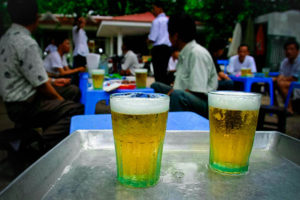
Bia Hơi Corner (Draft Beer)
Bia hoi corner isn’t a restaurant or a street food stall, but a junction in the Old Quarter that turns into the happiest place on earth every night. It looks like any other street corner during the day but at night, it transforms into a lively mix of locals and tourists sitting on low plastic stools and enjoying cheap beer over plates of tasty street food. If you like to drink beer, then you absolutely need to experience this.
The term bia hoi refers to Vietnamese draft beer. It’s a cheap type of draft beer that costs anywhere between VND 3,000-7,000 (around USD 0.13-0.30). Brewed daily and without preservatives, freshly made batches are delivered in steel barrels and typically consumed that same evening.
Bia Hơi can be consumed in bars throughout Hanoi but it’s best enjoyed at the corner of Ta Hien and Luong Ngoc Quyen Streets, aka “bia hoi corner” or “bia hoi junction”. There are many bars in and around this junction serving bia hoi and other brands of bottled beer.
- Address: Corner of Ta Hien & Luong Ngoc Quyen Streets
- Operating Hours: Mid-afternoon to late night
- What to Order: Beer and street food
- What We Paid: VND 3,000-7,000 (draft beer) / Around VND 25,000 (local beer)
19/ Cà Phê Trứng (Vietnamese Egg Coffee)
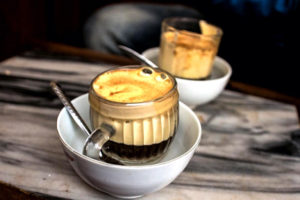
Cà Phê Trứng (Vietnamese Egg Coffee)
Although it is not a food, it is like food. Egg coffee or Cà Phê Trung is the most famous coffee in the north of Vietnam. It is a thick dark coffee topped with egg yolk whipped with condensed milk into an airy froth. Rich in taste, it can be likened to tiramisu dessert.
There are several coffee shops and places to enjoy a silky Vietnamese egg coffee. One place that offers the best view in Hanoi is a hidden and difficult to find coffee shop called Café Phố Cổ.
Café Phố Cổ
- Address: 11 Hàng Gai, Hàng Trống, Hà Nội
- Hours: Everyday from 8am until 11pm.
- Prices: About 30,000 VND for a cup of egg coffee ($1.34 USD)
Giảng Cafe
- Address: 39 Nguyễn Hữu Huân, Hàng Bạc, Hoàn Kiếm, Hà Nội
- Hours: Everyday from 7am until 10pm.
20/ Phở Cuốn (Rolls noodle)
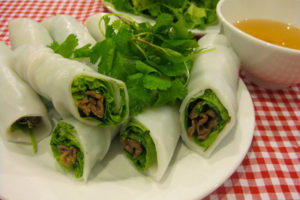
Phở Cuốn (Rolls noodle)
Phở Cuốn is basically all the ingredients of Pho, but without the broth. It consists of strips of grilled beef and lots of herbs like cilantro, basil, and mint, all rolled up in a wide rice noodle. So instead of using a spoon and chopsticks, you just dip them in a bowl of nước chấm (sweet fish sauce) and enjoy!
There is actually a whole neighborhood in Hanoi dedicated to Pho Cuon. The Trúc Bạch neighborhood of Hanoi, to the east of West Lake, is full of restaurants serving up Pho Cuon and it’s sister dish Phở Chiên Phồng
- Address: there are many restaurants serving pho rolls in Ngu Xa Street, District Ba Dinh.
- Price: 30,000 – 60,000 VND
21/ Nộm Bò Khô (Green Papaya Salad with Dried Beef)
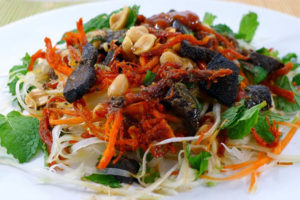
Nộm Bò Khô (Green Papaya Salad with Dried Beef)
Nộm Bò Khô is simply green papaya salad topped with dried beef that is quite similar to the beef jerky you’ll find in the USA.
The long, thin strips of beef that form the centerpiece of this dish are first soaked in a mixture of salt, sugar, garlic, oil, ginger, and chili to give it a spicy but sweet flavor. It soaks overnight and then the beef strips are dried in an oven.
The papaya salad is soaked in fish sauce, vinegar, sugar, chili, and soy sauce then tossed with fresh herbs like mint, parsley, and coriander. Top with dried beef and a few peanuts and you’ve got
- Address: 23 Hồ Hoàn Kiếm
22/ Bún Đậu Mắm Tôm (Noodle and Tofu with Shrimp Sauce)
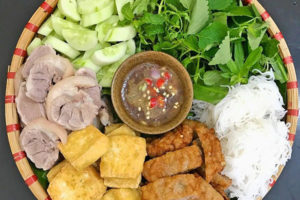
Bún Đậu Mắm Tôm (Noodle and Tofu with Shrimp Sauce)
Bún Đậu Mắm Tôm consists of 3 main parts. First you have vermicelli rice noodles (“Bún”) that have been stuck together in a big flat pancake and then cut into bite-sized pieces (called “bun mieng”). Second are squares of tofu (“Đậu”) fired to a golden brown so it’s crispy on the outside and soft on the inside. The final piece of this dish is the signature item – an extremely stinky bowl of fermented shrimp sauce (“Mắm Tôm”) to dip everything in.
While the shrimp paste doesn’t necessarily taste bad, the smell is pretty overpowering. Luckily, most restaurants will also bring you a bowl of fish sauce that you can use for dipping instead.
23/ Bánh Rán (Vietnamese Donuts)
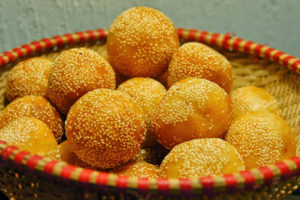
Bánh Rán (Vietnamese Donuts)
Bánh Rán are scrumptious little balls of fried glutinous rice flour. They are traditionally filled with mung bean paste and covered with sesame seeds. You’ll find a wide variety of these little donuts for sale by women wandering around the Old Quarter of Hanoi. Banh Ran roughly translates to “fried pastry” so it encompasses a lot of different versions of this treat including some savory options.
24/ Thịt Rắn (Cobra at Lệ Mật village)

Thịt Rắn (Cobra at Lệ Mật village)
Dining on snake is one of the most interesting things you can do in Hanoi. It’s really so much more than a meal – it’s a wildly bizarre dining adventure. First, you’ll be invited to choose your main course from a case of living cobras. Then, you watch as the cobra is beheaded and you’ll have the opportunity to suck down its heart in a shot glass of rice wine.
Next, the entire snake will be prepared into a huge feast of different dishes including grilled cobra ribs, crispy fried snake skin, and sauteed cobra stomach. Wash it all down with shots of rice wine, snake blood, snake bile, and ample Beer Hanoi – it’s an experience you won’t soon forget!
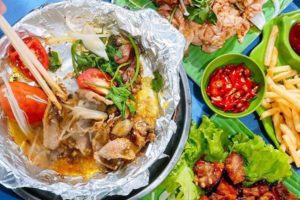
Grilled Pig’s Tripe on Gầm Cầu Street
25/ Grilled Pig’s Tripe on Gầm Cầu Street
There are a few restaurants located on Gam Cau street which is hard to believe since the street name literally translates to “under the bridge.” And Gam Cau street, as its name suggests, is really under some bridges in Hanoi. Settling down at the restaurant, trying grilled pig’s tripe, and watching the train pass by on the bridge will be a memorable and peaceful moment of your trip. These restaurants have several grilled dishes: tripe, stomach, rectum, beef, and more. I guarantee the food safety of these restaurants because of their reputation, so you don’t have to worry. If there are many Vietnamese there, eat there!
- Address: Gam Cau street, District Hoan Kiem.
- Price: 70,000 – 100,000 VND
26/ Quán Ăn Ngon – An easy one stop place for Vietnamese Cuisine

Quán Ăn Ngon – An easy one stop place for Vietnamese Cuisine
Quan An Ngon might not be street food but it is the most convenient one stop place to have Vietnamese food from around the region and in a comfortable setting.
While the food quality from Quan An Ngon might not be as fantastic as the one’s you find in the streets, they say if you are pushed for time and you want to try as many Vietnamese cuisine as possible ~ Quan An Ngon is your best bet!
- Quan An Ngon – 18 Phan Bội Châu, Cửa Nam
- Quan An Ngon – 29 Trần Hưng Đạo
MID RANGE WINE AND DINE COMFORTABLE RESTAURANTS
Here are some restaurants that are more comfortable and you can actually dress up, have wine and dine. I’ve dined in a few but they are pretty disappointing. Here aree my favourite and highly recommended.
Madame Hien
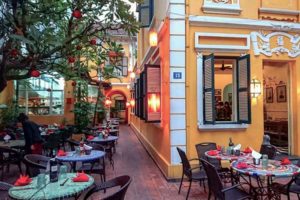
Madame Hien
Madame Hien is a French Vietnamese restaurant, set in a 19th-century villa, and us a tribute to their French chef Didier Corlu’s Vietnamese grandmother. This is a great place to wine and dine indulging in good Vietnamese food with a hint of French influence. A great place for you to dress up, have wine and enjoy a good dinner with someone special. Now would you look at that lovely duck!
- Address: Madame Hien Restaurant – 15 Chân Cầm street
Green Tangerine
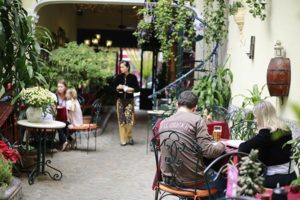
Green Tangerine
Green Tangerine Restaurant Hanoi is conveniently located in Old Quarter, where diners can enjoy authentic Vietnamese and French haute cuisine in a quaint setting. Opened in 2003, the brasserie-style restaurant occupies a refurbished 1920s French villa that’s fitted with rustic décor, bare bricked walls, and antique furnishing. It’s also surrounded by a lush garden, making it an ideal dining venue for those looking to escape Hanoi’s chaotic traffic.
- Address: Green Tangerine – 48 Hàng Bè street
Blue Butterfly Restaurant & Cooking class
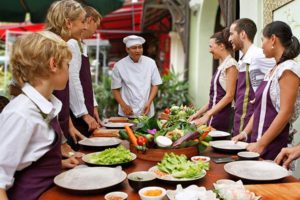
Blue Butterfly cooking class
Blue Butterfly is another good choice for expats around Old Quarter area for authentic Vietnamese traditional foods. Coming here and see how the restaurant differentiates itself from the others.
Tables and chairs of the restaurants are made from bamboo and wood resembling eating room of villagers in the countryside of Vietnam. Besides, beautiful pictures of stunning landscape may help enhancing your appetite. For whom interested in oriental gastronomy, Blue Butterfly offer you cooking courses lectured by experienced chefs of the restaurant. Fee for a daily cooking class is US$ 30, after the class, one may bring a part of the restaurant home with a full set of Vietnamese dishes like: .Green papaya salad, Hanoi spring rolls, Stir fried chicken with lemon grass.
- Address: 69 Mã Mây street, Hàng Buồm, Hoàn Kiếm, Hà Nội
Lang Liêu Restaurant
One reputed American novelist called Jonathan Safran Foer once said “Food is not rational. Food is culture, habit, craving and identity.” When it comes to cuisine, there will always be something to be told – a mark of culture, a piece of history and a flow of time. The stories brought to you by food is the most lively one, since it triggers such a sensational experience that you don’t merely listen with your ears but your heart as well.
Vietnamese people, who have treasured culinary art for centuries, do not cook with just normal ingredients. They imprint their soul in everything they cook. From the most recognized dish – Pho to a local one like Banh Gai, every single dish has its journey of life. Pho inherits the subtlety and harmony from its creator – a young Hanoi woman named Thi Ba who first made it for her French lover in 1900s. Meanwhile, Banh Gai marks an era of poverty across the Northern part, when people were so lacking in food that they mixed leaf with rice and it turned out to be the first version of Banh Gai.
- Address: 57 Đường Thành Str, Hoan Kiem Dist, Hanoi
Nam Phuong Restaurant
Opening in 1966, Nam Phuong is known as one of the finest Vietnamese Restaurant in Hanoi oriented toward foreigners. It is housed in a renovated old French villa in Phan Chu Trinh Street and located right in the center of Hanoi, the diplomatic and financial and close to the main tourist attraction: Hoan Kiem Lake, The Hanoi Opera House.
The ingredients in Nam Phuong is always carefully selected and skillfully prepared under the skilled of talented chefs. Thus, the dishes in Nam Phuong still retains traditional flavors added some modern style to create unique dishes.
With the enthusiastic and friendly staffs, the restaurant will give guests the best comfortable that they have never had.
- Address: 19 Phan Chu Trinh street – French Quarter
- Hours: 11:00am-14:00pm & 5:00pm-10:00pm
Wild Rice Restaurant
Situated in the villa built under the French period, Wild Rice restaurant has an elegant and ancient design. Wild Rice is one of the few restaurants reaches 5 stars standard in Hanoi, gathers all advantages of the big restaurant.
Come to Wild Rice, guests will be immersed in a European architecture space with gardens offers customers a relaxed ambiance while enjoying the food.
The particularity of Wild Rice restaurant is European style but serving pure Vietnamese food with unique flavor of a tropical country. Tourists can enjoy the typical dishes of Vietnam that are professional process such as: braised fish, duck with orange sauce, fried shrimp…
The restaurant has welcomed many heads and high-level delegations from many countries to visit and work in Vietnam and received much praise for the professional service style, luxurious space and the dishes with local characteristics.
- Address: 06 Ngô Thì Nhậm street
- Hours: 11:00am-14:00pm & 5:00pm-10:00pm
Sen Hanoi – Asian-style Buffet in Hanoi French Quarter
Sen Hanoi at 60 Ly Thai To stands out amongst most restaurants in Hanoi for serving extensive buffet-style dinners in a sophisticated setting. Attracting affluent locals and tourists looking to sample a variety of Vietnamese cuisine in a single sitting, the restaurant is set beside Hanoi Opera House, just across from the Sofitel Metropole hotel in Hanoi’s French Quarter.
There are three other branches of Sen in Hanoi but this is arguably the best of the bunch. Featuring an elegant black-and-white theme, it’s fitted with neo-colonial décor, chandeliers, mirrors, white tablecloths, wooden furnishing, a massive buffet area set up in the centre, and spacious seating arrangements that make Sen Hanoi feel like a proper sit-down restaurant.
Address: 60 Lý Thái Tổ street
Buffet Sen Tay Ho at Hanoi
Sen Tây Hồ (Sen West Lake Restaurant) is one of the biggest buffet restaurant in Hanoi. It offers Vietnamese, European, and Eastern Asian cuisine. In this restaurant, there are three type of buffet:
- International Buffet (Buffet Quốc Tế)
- Hanoi Buffet (Buffet Hà Nội)
- Luxury Star Buffet (Buffet Star)
Prices
| International BUFFET
Monday – Friday Lunch: adult $230,000VND, children $160,000VND Dinner: adult $270,000VND, children $180,000VND Saturday – Sunday Lunch: adult $270,000VND, children $180,000VND Dinner: adult $320,000VND, children $220,000VND |
Hanoi Buffet
Monday – Friday Lunch: adult $270,000VND, children $180,000VND Dinner: adult $320,000VND, children $220,000VND Saturday – Sunday Lunch: adult $340,000VND, children $240,000VND Dinner: adult $390,000VND, children $270,000VND |
Buffet Star
Monday – Friday Dinner: adult $370,000VND, children $260,000VND Saturday – Sunday Dinner: adult $420,000VND, children $290,000VND Location The address of the Sen West Lake Restaurant (Sen Tây Hồ) is Số 614 Lạc Long Quân, Nhật Tân, Tây Hồ, Hanoi, Vietnam. |
The address of the Sen West Lake Restaurant (Sen Tây Hồ) is Số 614 Lạc Long Quân, Nhật Tân, Tây Hồ, Hanoi,
Highlands Coffee
Highland’s is the local version of Starbucks — a popular place to beat the heat and have a good, strong cup of coffee. The best location is lakeside on the sixth floor of the massive wedge-shaped building that overlooks a busy traffic circle and the north end of the lake. Red couches are set up in intimate arrangements on platforms overlooking the busy anthill below: a good meeting point. Alternatively, it is head to their hip outdoor courtyard between the Hilton and the Hanoi Opera House. This is a great place to enjoy any kind of espresso or cappuccino, Italian sodas, snacks, sandwiches, pizzas, and good breakfasts, all while looking out over the lake or watching the hustle and flow of traffic below.
Tobe Continued
If you have a story to share or a question that has not been answered on our website, please contact us to get in touch with us via the contact details listed below:
- Address: Ho Guom Plaza Building, 102 Tran Phu Road, Ha Dong Dist, Hanoi city, Vietnam.
- Phone: +84 961738229
- Hotline: +84 975558866 (24/7/365 – Whatsapp/Viber/Line)
- Email: sales@hanoitoursexpert.com
- Skype: hanoitoursexpert
- Facebook: facebook.com/hanoitoursexpert

